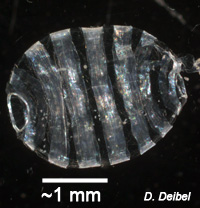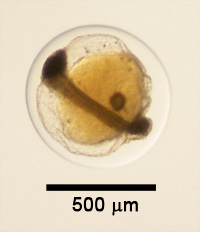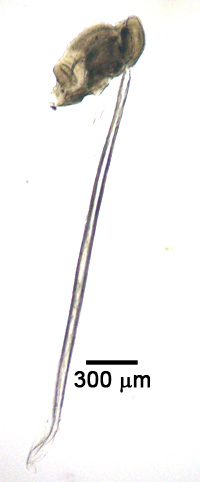Chordates(Phylum Chordata) Lancelet Larvae & Amphioxi   Tunicates   Fish eggs & larvae The phylum Chordata is a diverse assemblage of over 60,000 species that includes vertebrates, a group to which we humans belong, and gelatinous marine animals with primitive features. All chordates are characterized by the presence of a notochord (primitive backbone), hollow dorsal nerve cord, gill slits, endostyle (primitive thyroid gland), and a postanal tail during at least part of the life cycle. Chordates in the zooplankton include vertebrates (larval fish and fish eggs), cephalochordates (amphioxus, or lancelet larvae), and urochordates (tunicates). Tunicates in the zooplankton are the tadpole larvae of adult benthic tunicates, and three holoplanktonic taxa: appendicularians, doliolids and salps. Lancelet Larvae, or Amphioxus(return to top)Lancelets are primitive chordates in that their notochord persists throughout life, they have no vertebrae, cranium or jaws. Otherwise, they resemble primitive fish.  Branchiostoma spp. (formerly Amphioxous) Tunicates(return to top)AscidiansAscidians are meroplankton, in that only their tadpole larvae exist in the plankton, while the adults are benthic.  Tadpole larvae  Presettlement adult form AppendiculariansAppendicularians resemble the "tadpole larvae" of benthic tunicates and produce unique, temporary gelatinous "houses" to filter small plankton for food.  Oikopleura dioica  Appendicularia sicula  Fritillaria spp. Salps (Salp Thaliaceans)Salps (meaning "bag-shaped") have lifecycles which alternate between solitary individuals which asexually reproduce chains of individuals, which sexually reproduce the solitary individuals. Due to their asexual reproduction, salps can increase rapidly. Salps are distinguished from doliolid thaliaceans by their non-parallel muscle bands.  Thalia democratica (solitary)  Thalia democratica (solitary w/ chain of zooids)  Thalia democratica (aggregate chain of zooids) Doliolid (Doliolid Thaliaceans)Doliolids (barrel-shaped) are smaller than salps with more complicated lifecycle alternating between solitary individuals (oozooids) which develop tails that bud filter feeding gastrozooids, and phorozooids which produce gonozooids. Gonozooids sexually reproduce a tailed larva which grows into the solitary individuals to complete the cycle.  Dolioletta gegenbauri (gonozooid: coiled gut, 8 muscle bands, & no tail)  Dolioletta gegenbauri (nurse w/ zooids on tail)  Dolioletta gegenbauri (closeup of tail w/ zooids) Fish eggs & Larvae(return to top)Of all zooplankton, fish are humans’ closest relatives. Although fish leave the zooplankton as they enter into adulthood and become free-swimmers, their larvae and eggs drift with the currents and are thus an important component of zooplankton. Below are some fish zooplankton common in the plankton assemblages of Mid-Atlantic waters.  Fish egg w/ embryo and yolk. Typical fish egg of many species.  Fish larva w/ yolk sac. Representative of many species.  Fish larva representative of many species. |